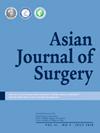Long-term quality of life after microscopic and endoscopic transsphenoidal pituitary adenoma surgery: A retrospective cohort study
IF 3.8
3区 医学
Q1 SURGERY
引用次数: 0
Abstract
Background
Transsphenoidal surgery is the primary treatment for pituitary adenomas, yet the long-term quality of life (LTQoL) outcomes following microscopic transsphenoidal surgery (MTSS) and endoscopic transsphenoidal surgery (ETSS) remain underexplored. This study compared postoperative complications and LTQoL (>24 months) between these two approaches.
Methods
This retrospective study analyzed 103 patients who underwent their first transsphenoidal pituitary adenoma resection at Beijing Tiantan Hospital (2015–2022). Patients were categorized into the MTSS group (n = 55) and ETSS group (n = 48). LTQoL was assessed using the Anterior Skull Base Questionnaire (ASBQ) and Sino-Nasal Outcome Test-22 (SNOT-22). Statistical analyses were performed to compare postoperative complications and LTQoL outcomes.
Results
No significant differences were observed in postoperative infections (P = 0.566), diabetes insipidus (P = 0.414), vision recovery (P = 0.064), and hyponatremia (P = 0.931). However, ETSS had a higher cerebrospinal fluid (CSF) leakage rate (16.7 % vs. 3.6 %, P = 0.042) but a significantly higher gross-total resection (GTR) rate (83.3 % vs. 25.5 %, P < 0.05). Regression analysis showed SNOT-22 scores were associated with surgical approach, cavernous sinus invasion, cerebrospinal fluid (CSF) leakage, and visual deterioration. Tumor size and hospital stay negatively impacted both ASBQ and SNOT-22 scores, while PIT1-lineage tumors were protective for ASBQ scores.
Conclusion
Both MTSS and ETSS are effective, but ETSS is preferred for tumors extending beyond the sella due to its higher GTR rate and better nasal-related LTQoL, despite an increased risk of CSF leakage.
经蝶窦垂体腺瘤手术后的长期生活质量:一项回顾性队列研究
背景:经蝶窦手术是垂体腺瘤的主要治疗方法,但显微经蝶窦手术(MTSS)和内窥镜经蝶窦手术(ETSS)后的长期生活质量(LTQoL)结果仍未得到充分研究。本研究比较了两种入路的术后并发症和LTQoL(24个月)。方法回顾性分析2015-2022年在北京天坛医院首次行垂体蝶窦腺瘤切除术的103例患者。将患者分为MTSS组(55例)和ETSS组(48例)。LTQoL采用前颅底问卷(ASBQ)和鼻-鼻预后测试-22 (SNOT-22)进行评估。对术后并发症和长期生活质量结果进行统计分析。结果两组术后感染(P = 0.566)、尿漏症(P = 0.414)、视力恢复(P = 0.064)、低钠血症(P = 0.931)差异无统计学意义。然而,ETSS有较高的脑脊液(CSF)漏出率(16.7%比3.6%,P = 0.042),但总切除(GTR)率显著较高(83.3%比25.5%,P < 0.05)。回归分析显示,SNOT-22评分与手术入路、海绵窦侵犯、脑脊液(CSF)渗漏和视力恶化有关。肿瘤大小和住院时间对ASBQ和SNOT-22评分均有负向影响,而pit1谱系肿瘤对ASBQ评分有保护作用。结论MTSS和ETSS均有效,但ETSS虽然增加了脑脊液漏的风险,但由于其较高的GTR率和较好的鼻相关LTQoL,因此更适合扩展到鞍外的肿瘤。
本文章由计算机程序翻译,如有差异,请以英文原文为准。
求助全文
约1分钟内获得全文
求助全文
来源期刊

Asian Journal of Surgery
医学-外科
CiteScore
3.60
自引率
31.40%
发文量
1589
审稿时长
33 days
期刊介绍:
Asian Journal of Surgery, launched in 1978, is the official peer-reviewed open access journal of the Asian Surgical Association, the Taiwan Robotic Surgery Association, and the Taiwan Society of Coloproctology. The Journal is published monthly by Elsevier and is indexed in SCIE, Medline, ScienceDirect, Scopus, Embase, Current Contents, PubMed, Current Abstracts, BioEngineering Abstracts, SIIC Data Bases, CAB Abstracts, and CAB Health.
ASJSUR has a growing reputation as an important medium for the dissemination of cutting-edge developments in surgery and its related disciplines in the Asia-Pacific region and beyond. Studies on state-of-the-art surgical innovations across the entire spectrum of clinical and experimental surgery are particularly welcome.
The journal publishes original articles, review articles, and case reports that are of exceptional and unique importance. The journal publishes original articles, review articles, and case reports that are of exceptional and unique importance.
 求助内容:
求助内容: 应助结果提醒方式:
应助结果提醒方式:


